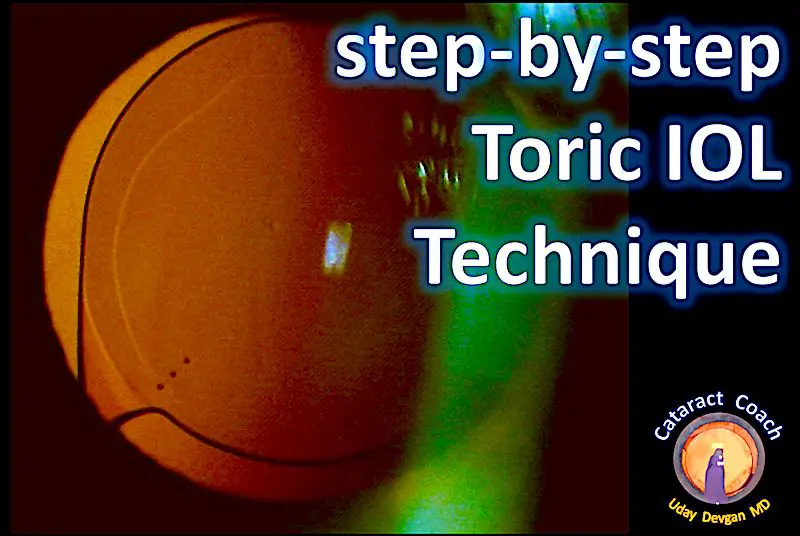What is astigmatism?
Astigmatism is an imperfection in the curved shape of the front surface of the eye (the cornea) or the lens inside the eye (1). It causes blurred vision at all distances (2). With astigmatism, light rays focus on more than one point on the retina rather than just one point. This results in distorted and blurred vision (3).
Astigmatism is very common, affecting around 1 in 3 adults to some degree. It often occurs along with other refractive errors like nearsightedness (myopia) and farsightedness (hyperopia) (1). Among cataract surgery patients, studies show a prevalence of pre-existing astigmatism ranging from 30% to 60% (4).
The degree of astigmatism is measured in diopters. Mild astigmatism ranges from 0.50 to 1.00 diopter. Moderate astigmatism falls between 1.25 to 2.00 diopters. Severe astigmatism is greater than 2.00 diopters (2). Higher amounts of astigmatism lead to greater visual distortion and difficulty seeing clearly.

Sources:
(1) https://www.mayoclinic.org/diseases-conditions/astigmatism/symptoms-causes/syc-20353835
(2) https://www.aao.org/eye-health/diseases/what-is-astigmatism
(3) https://www.nei.nih.gov/learn-about-eye-health/eye-conditions-and-diseases/astigmatism
(4) https://pubmed.ncbi.nlm.nih.gov/29960098/
Medicare coverage for cataract surgery
Original Medicare Part B covers traditional cataract surgery when medically necessary. This includes the removal of the cloudy lens and insertion of an artificial lens (1).
To qualify for coverage, Medicare requires that you have significant cataract-caused vision impairment documented by an ophthalmologist or optometrist (2). There must be adequate documentation showing that the cataract interferes with your everyday activities.
Medicare covers the surgeon fees, facility fees, anesthesia, and basic artificial lenses needed for traditional cataract surgery. However, Medicare does not cover premium lens implants like toric lenses that correct astigmatism or multifocal lenses for near and far vision (3). You may have to pay extra out-of-pocket costs for these upgraded lenses.
Most Medicare Advantage plans also cover traditional cataract surgery following Medicare guidelines (1). However, Advantage plans may offer some additional coverage for premium lenses.
Sources:
(1) https://www.humana.com/medicare/medicare-resources/does-medicare-cover-cataract-surgery
(2) https://www.medicare.gov/coverage/eyeglasses-contact-lenses
(3) https://www.forbes.com/health/medicare/does-medicare-cover-cataract-surgery/
Does Medicare cover toric IOLs for astigmatism?
Toric intraocular lenses (IOLs) are a special type of artificial lens implant used in cataract surgery. They are designed to correct pre-existing astigmatism as well as restore visual clarity, allowing many patients to reduce or eliminate their need for glasses or contact lenses post-surgery.

The benefits of toric IOLs over glasses and contacts include improved uncorrected vision, freedom from glasses for certain activities, and avoiding the hassle of glasses that can slip or get dirty. Toric lenses also correct astigmatism in all lighting conditions and head/eye positions.
Unfortunately, Original Medicare does not cover the additional cost of toric IOLs. Medicare has deemed toric lenses “not medically necessary.” Only standard monofocal IOLs are covered (source). The patient is responsible for the added expense of astigmatism-correcting toric lenses, which can range from $500-$2,500 per eye depending on the model and prescription strength required.
Some Medicare Advantage plans may offer additional coverage for toric IOLs. Patients can contact their plan directly to check coverage details.
Even without insurance coverage, many patients still opt for toric IOLs to maximize their vision and reduce dependency on glasses and contacts after cataract surgery.
Medicare Advantage Plan Options
Medicare Advantage plans, also known as Medicare Part C, offer an alternative to Original Medicare. These plans are offered by private insurance companies and bundle Medicare Part A and Part B coverage. Medicare Advantage plans may also provide additional benefits beyond what Original Medicare covers, such as vision, dental, hearing aids, and prescription drugs.
When it comes to cataract surgery, Medicare Advantage plans must cover the standard procedure to remove the cataract and insert a basic artificial lens. However, coverage can vary compared to Original Medicare when it comes to advanced lenses that correct astigmatism. Some Medicare Advantage plans may help pay for astigmatism-correcting toric lenses, while others will not cover any costs beyond the basic cataract surgery [1].

Those considering cataract surgery with astigmatism correction should carefully review their Medicare Advantage plan’s coverage details. Some plans that may offer additional coverage for premium lenses and astigmatism correction include UnitedHealthcare AARP Medicare Advantage plans, Humana Gold Plus plans, and Blue Cross Blue Shield MA plans. However, out-of-pocket costs can still be high, so it’s important to confirm copays, coinsurance, and deductibles with your plan [2].
Out-of-pocket Costs
With Original Medicare, you will typically have out-of-pocket costs for cataract surgery. According to Medicare.gov, in 2022 the national average cost for cataract surgery performed in an ambulatory surgical center was $1,789. This includes $750 for the surgeon fee and $1,039 for the facility fee. You will be responsible for paying 20% of the Medicare-approved amount after you meet your Part B deductible, which was $226 in 2022.
The type of intraocular lens (IOL) implanted during cataract surgery can significantly impact your out-of-pocket costs. A standard monofocal IOL covered by Medicare typically costs between $50-$350 out of pocket. However, advanced IOLs like toric and multifocal lenses that correct astigmatism and presbyopia often cost $500-$4,000 or more out of pocket since they are not covered. You’ll want to speak with your eye doctor about IOL options to understand the benefits and costs of each.
There are a few ways to potentially reduce your out-of-pocket expenses for cataract surgery:
- Use an in-network ambulatory surgery center – they have contracted rates with Medicare and cannot charge more than the Medicare-approved amount.
- Ask your provider to code the cataract surgery as medically necessary if you have complications or comorbidities.
- Enroll in a Medicare Advantage plan – many include extra vision coverage that reduces copays for cataract surgery.
- Apply for financial assistance programs offered by some lens manufacturers.
Finding Medicare Providers
When looking for a Medicare provider for cataract surgery, there are a few key things to consider:
Use Medicare’s Care Compare tool to find in-network surgeons in your area: https://www.medicare.gov/care-compare/?providerType=Physician&redirect=true
You can search by location, compare measures of quality, and see if the provider accepts Medicare assignment. This ensures they accept Medicare rates as payment in full.
Castle Connolly is another directory that allows you to search for top-rated cataract surgeons covered by Medicare near you: https://www.castleconnolly.com/expertise/cataract-surgery
When speaking with potential surgeons, ask about their experience with complex cases, IOL options for astigmatism like toric lenses, and what out-of-pocket costs you may incur.
Confirm that they are in-network for your Medicare plan. Being out-of-network can lead to much higher out-of-pocket expenses.
Choosing an experienced, highly rated surgeon in-network with your Medicare coverage is key to getting excellent care and minimizing surprise bills.
Alternatives to surgery
For some patients, cataract surgery may not be the best option. There are alternatives to surgery that can also effectively treat astigmatism. Some alternatives including wearing prescription glasses or contacts.
Glasses and contact lenses are non-invasive and carry little to no risk compared to surgery. They can provide good visual correction for mild to moderate astigmatism. According to the American Optometric Association, glasses and contacts may be preferable for astigmatism under 1.00 diopter [1]. They are also a good option if the astigmatism is stable and unlikely to worsen over time.
The downside is that glasses and contacts need to be worn constantly for vision correction. They may be inconvenient compared to a permanent surgical solution. Patients with severe astigmatism are less likely to achieve clear vision with glasses or contacts alone and may still require surgery.
Overall, for milder cases of stable astigmatism, vision correction through prescription lenses can be an effective alternative to pursing surgery like cataract removal. Patients should discuss their options with their eye doctor.
Risks and complications
Like any surgical procedure, toric IOL implantation has potential risks and complications to be aware of [1]:
- Astigmatism undercorrection or overcorrection – The toric IOL may not fully correct pre-existing astigmatism or could overcorrect and induce astigmatism [2].
- Axis misalignment – Improper alignment of the toric lens could reduce effectiveness in correcting astigmatism [3].
- Lens rotation – The toric lens could rotate out of position post-surgery, shifting its astigmatic correction [1].
- Inflammation – Post-op inflammation inside the eye could cause complications [2].
- Infection – As with any surgery, there is a small risk of infection [3].
In general, toric IOLs have demonstrated excellent safety and effectiveness. Large clinical studies have found the need for toric IOL revision or repositioning to be very low, between 1-3% [2]. Still, the risks should be discussed with your ophthalmologist.
Recovery expectations
The typical recovery time after cataract surgery is around 4-6 weeks, but vision usually starts improving within the first few days (NHS). Here’s what to expect for recovery and post-op care:

In the first 1-2 days after surgery, your vision will be quite blurry. Your eye may be sensitive to light and movement. Your doctor will likely recommend wearing an eye shield at night for about a week after surgery to protect your eye as it heals (Cleveland Clinic).
Your doctor will give you antibiotic eye drops to use for about 2 weeks after surgery to prevent infection. You’ll need to avoid rubbing or pressing on your eye during the healing process. Most doctors recommend limiting activities for 1-2 weeks after surgery.
For the first week, avoid strenuous exercise, bending over too far, heavy lifting, and activities where you could bump your head. Don’t drive until your doctor says it’s safe to do so, usually about 1-2 weeks after surgery. Avoid getting water in your eye for 2-4 weeks after surgery.
Follow your doctor’s specific guidelines on post-op care and activity restrictions. With proper rest and recovery care, most patients are able to resume normal activities within a month after cataract surgery.
Making a decision
Cataract surgery is a highly personalized decision based on your specific vision needs and eye health. Here are some key considerations when deciding if cataract surgery is right for you:
Questions to ask your doctor:
- How severe is my cataract? Is it impacting my vision or activities of daily living?
- What are the benefits and risks of surgery for my particular case?
- Which type of lens implant would you recommend for me and why?
- How much improvement in my vision can I expect after surgery?
- Are there any alternatives to surgery I should consider first?
Determining if surgery is right for you:
- Consider how bothersome your cataract symptoms are and any functional vision limitations you’re experiencing.
- Think about your lifestyle and visual needs – reading, driving, work, hobbies, etc.
- Discuss the pros and cons of surgery with your eye doctor.
- Have realistic expectations about possible vision outcomes.
- Weigh the risks and benefits based on your eye health.
Next steps if pursuing surgery:
- Choose an experienced cataract surgeon you trust.
- Have a complete eye exam to determine if you are a good candidate.
- Learn what to expect before, during and after surgery.
- Arrange transportation and follow all pre-operative instructions.
Cataract surgery is one of the most common and successful procedures done today. Being informed and proactive will help lead you to the best decision for your eyes (Sniatecki 2015). Discuss any questions or concerns thoroughly with your ophthalmologist.

